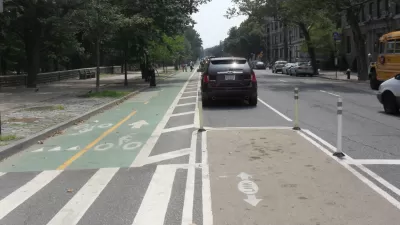Could a recent article in The New York Times that profiled extreme bicycle commutes of up to 40 miles (one way) be harmful to the advancement of bicycle use among ordinary individuals?
In her response to the Times piece that profiled the commuting habits of "Lycra-clad suburbanites" such as Christian Edstrom, who bicycles 80 miles round trip twice a week to his job at JP Morgan, Sarah Goodyear agrees with photographer Dmitry Gudkov's assessment that the story is "completely alienating to 98 percent of people who might want to ride to work."
"Gudkov is right that the image of the road warrior in space-age gear, pedaling a custom-built bike worth thousands of dollars over icy predawn roads, is off-putting to most ordinary folks," argues Goodyear. "And it’s ordinary folks who make up 98 percent of New Yorkers who use bicycles for transportation in New York City."
So, in addition to being alienating, could such portrayals actually be harmful to expanding bike infrastructure?
All bike riders, from the "Type-A strivers on their carbon-fiber steeds" to "the 82-year-old photographer on his cruiser", "benefit from an increased recognition that bicycles are a legitimate way to get from one place to another, and that you don’t have to be some kind of a freak to use them," says Goodyear.
"That recognition is not merely symbolic. It becomes very tangible in the form of protected bicycle infrastructure, such as the trails cited in the Times article, and in pro-bicycle regulations -- such as the Bicycle Access to Office Buildings Law, instituted in 2009, which requires many office buildings to grant access to bikes."
Of note: look for Edstrom's thoughts in the comments section of the article.
FULL STORY: You Don't Have to Be Superhuman to Commute by Bicycle

Alabama: Trump Terminates Settlements for Black Communities Harmed By Raw Sewage
Trump deemed the landmark civil rights agreement “illegal DEI and environmental justice policy.”

Study: Maui’s Plan to Convert Vacation Rentals to Long-Term Housing Could Cause Nearly $1 Billion Economic Loss
The plan would reduce visitor accommodation by 25% resulting in 1,900 jobs lost.

Planetizen Federal Action Tracker
A weekly monitor of how Trump’s orders and actions are impacting planners and planning in America.

Waymo Gets Permission to Map SF’s Market Street
If allowed to operate on the traffic-restricted street, Waymo’s autonomous taxis would have a leg up over ride-hailing competitors — and counter the city’s efforts to grow bike and pedestrian on the thoroughfare.

Parklet Symposium Highlights the Success of Shared Spaces
Parklets got a boost during the Covid-19 pandemic, when the concept was translated to outdoor dining programs that offered restaurants a lifeline during the shutdown.

Federal Homelessness Agency Places Entire Staff on Leave
The U.S. Interagency Council on Homelessness is the only federal agency dedicated to preventing and ending homelessness.
Urban Design for Planners 1: Software Tools
This six-course series explores essential urban design concepts using open source software and equips planners with the tools they need to participate fully in the urban design process.
Planning for Universal Design
Learn the tools for implementing Universal Design in planning regulations.
Caltrans
Smith Gee Studio
Institute for Housing and Urban Development Studies (IHS)
City of Grandview
Harvard GSD Executive Education
Toledo-Lucas County Plan Commissions
Salt Lake City
NYU Wagner Graduate School of Public Service



























